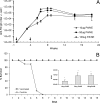Mucosal immunization with a novel nanoemulsion-based recombinant anthrax protective antigen vaccine protects against Bacillus anthracis spore challenge
- PMID: 17502384
- PMCID: PMC1952013
- DOI: 10.1128/IAI.00070-07
Mucosal immunization with a novel nanoemulsion-based recombinant anthrax protective antigen vaccine protects against Bacillus anthracis spore challenge
Abstract
The currently available commercial human anthrax vaccine requires multiple injections for efficacy and has side effects due to its alum adjuvant. These factors limit its utility when immunizing exposed populations in emergent situations. We evaluated a novel mucosal adjuvant that consists of a nontoxic, water-in-oil nanoemulsion (NE). This material does not contain a proinflammatory component but penetrates mucosal surfaces to load antigens into dendritic cells. Mice and guinea pigs were intranasally immunized with recombinant Bacillus anthracis protective antigen (rPA) mixed in NE as an adjuvant. rPA-NE immunization was effective in inducing both serum anti-PA immunoglobulin G (IgG) and bronchial anti-PA IgA and IgG antibodies after either one or two mucosal administrations. Serum anti-PA IgG2a and IgG2b antibodies and PA-specific cytokine induction after immunization indicate a Th1-polarized immune response. rPA-NE immunization also produced high titers of lethal-toxin-neutralizing serum antibodies in both mice and guinea pigs. Guinea pigs nasally immunized with rPA-NE vaccine were protected against an intradermal challenge with approximately 1,000 times the 50% lethal dose ( approximately 1,000x LD(50)) of B. anthracis Ames strain spores (1.38 x 10(3) spores), which killed control animals within 96 h. Nasal immunization also resulted in 70% and 40% survival rates against intranasal challenge with 10x LD(50) and 100x LD(50) (1.2 x 10(6) and 1.2 x 10(7)) Ames strain spores. Our results indicate that NE can effectively adjuvant rPA for intranasal immunization. This potentially could lead to a needle-free anthrax vaccine requiring fewer doses and having fewer side effects than the currently available human vaccine.
Figures






Similar articles
-
Aerosolized Intratracheal Inoculation of Recombinant Protective Antigen (rPA) Vaccine Provides Protection Against Inhalational Anthrax in B10.D2-Hc0 Mice.Front Immunol. 2022 Jan 26;13:819089. doi: 10.3389/fimmu.2022.819089. eCollection 2022. Front Immunol. 2022. PMID: 35154137 Free PMC article.
-
Nasal immunization with anthrax protective antigen protein adjuvanted with polyriboinosinic-polyribocytidylic acid induced strong mucosal and systemic immunities.Pharm Res. 2006 Jun;23(6):1217-26. doi: 10.1007/s11095-006-0206-9. Epub 2006 May 25. Pharm Res. 2006. PMID: 16718616
-
Efficacy of a vaccine based on protective antigen and killed spores against experimental inhalational anthrax.Infect Immun. 2009 Mar;77(3):1197-207. doi: 10.1128/IAI.01217-08. Epub 2008 Dec 29. Infect Immun. 2009. PMID: 19114543 Free PMC article.
-
Progress and novel strategies in vaccine development and treatment of anthrax.Immunol Rev. 2011 Jan;239(1):221-36. doi: 10.1111/j.1600-065X.2010.00969.x. Immunol Rev. 2011. PMID: 21198675 Review.
-
Vaccines against anthrax based on recombinant protective antigen: problems and solutions.Expert Rev Vaccines. 2019 Aug;18(8):813-828. doi: 10.1080/14760584.2019.1643242. Epub 2019 Aug 6. Expert Rev Vaccines. 2019. PMID: 31298973 Review.
Cited by
-
Nanoemulsion nasal adjuvant W₈₀5EC induces dendritic cell engulfment of antigen-primed epithelial cells.Vaccine. 2013 Feb 4;31(7):1072-9. doi: 10.1016/j.vaccine.2012.12.033. Epub 2012 Dec 25. Vaccine. 2013. PMID: 23273511 Free PMC article.
-
Colonic immune stimulation by targeted oral vaccine.PLoS One. 2013;8(1):e55143. doi: 10.1371/journal.pone.0055143. Epub 2013 Jan 30. PLoS One. 2013. PMID: 23383086 Free PMC article.
-
Nanoparticle Vaccines Against Infectious Diseases.Front Immunol. 2018 Oct 4;9:2224. doi: 10.3389/fimmu.2018.02224. eCollection 2018. Front Immunol. 2018. PMID: 30337923 Free PMC article. Review.
-
Nanocarriers-Assisted Needle-Free Vaccine Delivery Through Oral and Intranasal Transmucosal Routes: A Novel Therapeutic Conduit.Front Pharmacol. 2022 Jan 11;12:757761. doi: 10.3389/fphar.2021.757761. eCollection 2021. Front Pharmacol. 2022. PMID: 35087403 Free PMC article. Review.
-
A Comprehensive Overview on the Production of Vaccines in Plant-Based Expression Systems and the Scope of Plant Biotechnology to Combat against SARS-CoV-2 Virus Pandemics.Plants (Basel). 2021 Jun 15;10(6):1213. doi: 10.3390/plants10061213. Plants (Basel). 2021. PMID: 34203729 Free PMC article. Review.
References
-
- Ascenzi, P., P. Visca, G. Ippolito, A. Spallarossa, M. Bolognesi, and C. Montecucco. 2002. Anthrax toxin: a tripartite lethal combination. FEBS Lett. 531:384-388. - PubMed
-
- Baillie, L. 2001. The development of new vaccines against anthrax. J. Appl. Microbiol. 9:609-613. - PubMed
-
- Baker, J. R. J., D. C. Wright, M. M. Hayes, T. Hamouda, and J. Brisker. January 2000. Methods for inactivating bacteria including bacterial spores. U.S. patent 6,015,832.
-
- Baldrick, P., D. Richardson, G. Elliott, and A. W. Wheeler. 2002. Safety evaluation of monophosphoryl lipid a (MPL): an immunostimulatory adjuvant. Regul. Toxicol. Pharmacol. 35:398-413. - PubMed
-
- Baldridge, J. R., and R. T. Crane. 1999. Monophosphoryl lipid A (MPL) formulations for the next generation of vaccines. Methods 19:103-107. - PubMed
Publication types
MeSH terms
Substances
Grants and funding
LinkOut - more resources
Full Text Sources
Other Literature Sources
Medical
Research Materials
Miscellaneous

